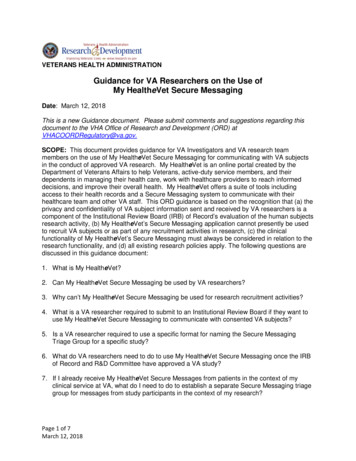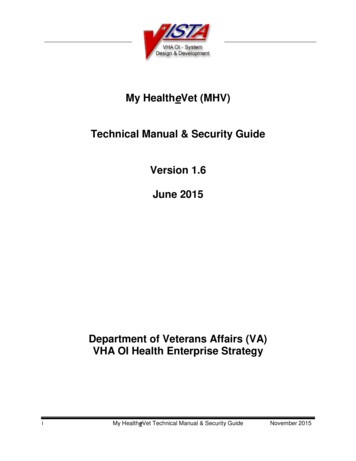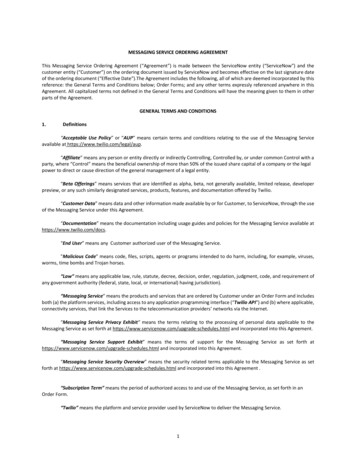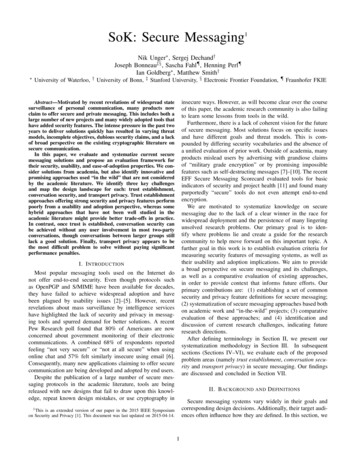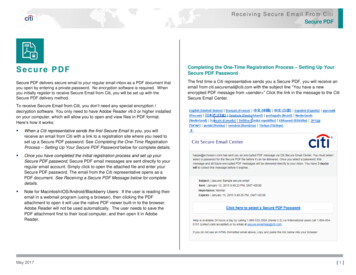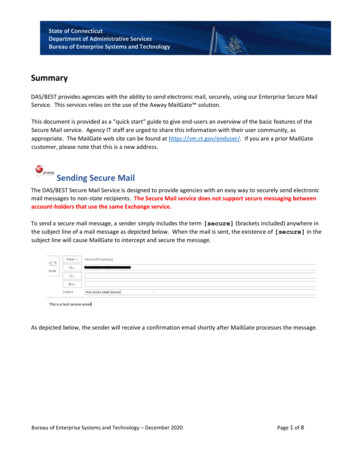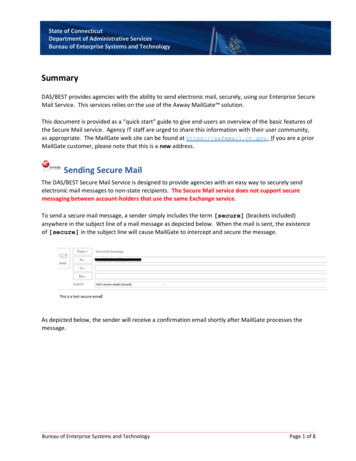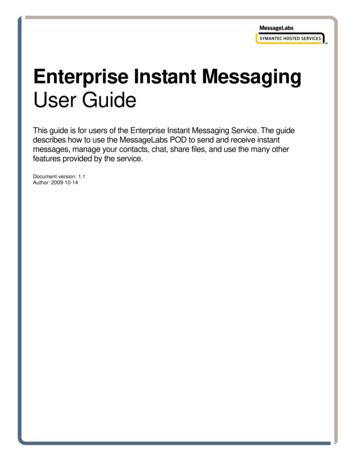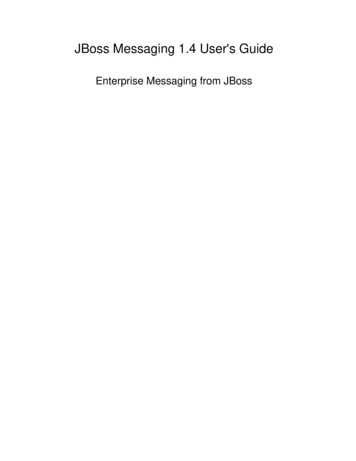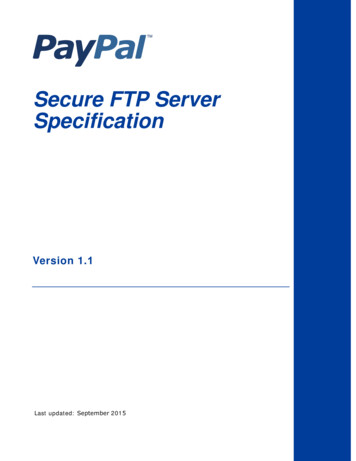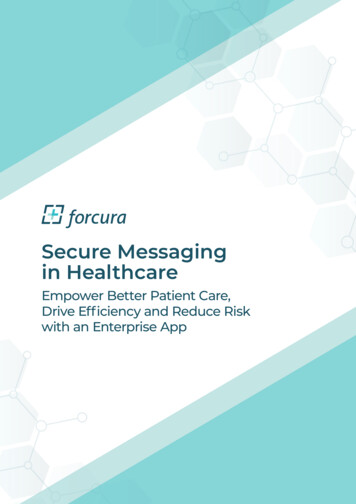
Transcription
Secure Messagingin HealthcareEmpower Better Patient Care,Drive Efficiency and Reduce Riskwith an Enterprise App
OverviewSustainable healthcare organizationsmust be able to survive the changinghealthcare landscape and continueto make a real difference for theircommunities and patients. This isdependent on their ability to evolve,become more operationally nimble, andintegrate new technologies into everydaybusiness practice.Mobile has quickly become the simplestand most efficient way to do business.This presents many opportunitiesin healthcare, allowing providers tomanage patients and patient data fromdisparate locations. In many cases theimplementation of an enterprise-widesecure messaging solution can transforman organization, enabling it to providebetter patient care and remain financiallysolvent for years to come. The challenge,however, is that traditional third-partymobile messaging applications donot work in healthcare due to HIPAArequirements and the need to transmitand store personal health information.1 Smith, Aaron (April 1, 2015). US Smartphone Use in 2015.Pew Research Center. Retrieved from e-use-in-2015/2The U.S. Department of Health and HumanServices Office of the National Coordinatorfor Health IT (ONC) defines secure messagingin healthcare as “the secure and protectedtransmission of information betweenpatients and their providers, includingclinicians and their support staff.” 1To take full advantage of the opportunitiesmobility provides, healthcare executivesshould implement an ed specifically for the complexitiesof this industry. By carefully selecting theright app and implementing it systemwide, organizations can capitalize on theefficiencies that mobile technology provides,while also alleviating privacy concerns.
The Evolution of MobileThe rise of the mobile device and mobilecommunication has drastically changedthe way the world communicates anddoes business.Today, nearly two-thirds of Americanadults own a smartphone1. As thisnumber grows, smart phones, cellphones, and tablets increasingly becomethe most efficient and reliable way tocommunicate, both inside and outside ofthe workplace.Text messaging, introduced over twentyyears ago, is the most prevalent formof communication today and the mostused data service in the world.2 In 2015,the number of text messages sent wasestimated to be 8.3 trillion3 with over 6billion text messages sent per day in theU.S. alone.4Why? Mobile communication is faster andmore effective than other more traditionalforms of digital communication. Textmessages have a 98% open ratecompared to 20% for emails5, with 90%of all text messages being read within 3minutes of delivery.6As the healthcare industry evolves,more and more emphasis is placed onsupporting patients in post- acute settingssuch as remote health, home health andtelemedicine. Mobile communicationbecomes a key to providing the bestand timeliest patient care. Mobile3messaging empowers disparate membersof a care team to make collaborative realtime decisions from anywhere, at anytime. According to a recent University ofPennsylvania study published in the Journalof General Internal Medicine, physicianswho managed patient care through securetext messaging saw a 14% decrease inpatient hospitalization time over patientsmanaged by the traditional pager system.7Mobile communication becomesa key to providing the best andtimeliest patient care.Nevertheless, simple text messaging or theavailable third-party messaging apps thatphysicians, clinicians, and support staff useon a daily basis for other aspects of theirlives simply do not work for the business ofhealthcare. In some cases clinical workersare asked to “lock up” their smartphoneswhen they arrive on the job and do better,faster patient care with 1980’s technology.2 Burke, Kenneth. (August 4, 2015). 8 Reasons Why Texting is Crucial to BusinessCommunication.3 OneReach. 45 Statistics That Prove Businesses Need to Take SMS Seriously.Retrieved from: http://onereach.com/blog/45-texting- ng-sms-seriously/4 O’Grady, Michael. (June 19, 2012). SMS Usage Remains Strong in the US.5 Essany, Michael. (August 6, 2014). SMS Marketing Wallops Email. Retrieved - 66/6 Connect Mogul. (March 22, 2013). Texting Statistics. Retrieved from: /7 MedicalXpress. (April 5, 2016). More effective communicationamong care team may allow for shorter hospitalization
The Healthcare ChallengeUsing the latest technology whilesafeguardingprotectedhealthinformation (PHI) can be a challenge,even for the most stable and advancedhealthcare providers. Internal policiesand procedures may protect thisinformation in the back-office, but oftendo not apply to PHI sent and retrievedin the field. Organizations that are notactively enforcing procedures for storing,sending, and receiving PHI in the fieldcould face HIPAA violations, criminalcharges, or civil legal action.Still, field and back-office staff confrontthe increasing pressure and demandto communicate in real-time. Delays incommunication can result in missedreferrals, increased FTE expenditures,and substandard patient care. The abilityto send messages, images, and files fromanywhere on any device is becoming arequirement, not a nice-to-have, in anysustainable healthcare organization.To meet this demand, many providersand healthcare administrators are usingmobile apps like WhatsApp, GroupMe,and Facebook Messenger, along withconventional SMS to get the job done.These third-party methods are moredirect and personal, making it morelikely that the recipient will respond in atimely manner, but they are not HIPAAcompliant means of communication andintroduce significant institutional risk.Text messaging is only compliant whenencryption and physical data protectionare applied. Compliant texting requiresthe ability to delete information remotelyif the device is stolen or misplaced.Popular mobile apps don’t require asecure login and can be easily accessedby other parties.48 Hales, Paul. (January 26, 2016). HIPAA Challenges in Email and SMS.MentorHealth. Retrieved on http://www.mentorhealth.com/control/ wproduct/ product id 800649LIVE?channel mailer&camp webinar&AdGroup PAUL HALES FEB17 JAN26 EXPRESSMessages sent through these means alsorun the risk of being intercepted or hacked.Misdialed numbers or unintended messagerecipients can result in a breach of PHI. Inturn, the patient’s privacy is compromised,in some cases leading to identity theft andsevere HIPAA violations. MentorHealthargues that health records are morevaluable on today’s black market than socialsecurity or credit card numbers.8 With thatin mind, security is critical in handling andcommunicating patient information.Further exacerbating the risk is providers’inability to track and prevent HIPAAinfractions. Because this communicationoften takes place on employees’ personalsmartphones, regulation can be nearlyimpossible. While some employers offerBring Your Own Device (BYOD) encryptionservices, employees prefer not to handover their personal smartphones, grantingcomplete access to their sensitive personalinformation.Alternatively, some organizations opt toprovide encrypted smartphones for theiremployees. This costly option requiressignificant IT involvement and can bedifficult to manage as hardware is lost,stolen, breaks, or needs to be upgraded.Whether implementing a BYOD policy orproviding devices for your team, monitoringthe data and methods of communicationis still a challenge. Ultimately, it is theprovider’s duty to deliver the best patientcare possible. Secure communication is vitalto providing a consistent, HIPAA-compliantcare experience.
The SolutionAs a healthcare provider what shouldyou do? How do you meet the increasingbusiness demands of your organizationwhile ensuring administrative, physicaland technical safeguards?The simplest, most effective solutionis the implementation of an enterprisesecure messaging platformdesignedspecifically for healthcare. In May of 2016the Joint Commission ended its five-yearban on text messaging and announcedthat practitioners may text orders aslong as a secure text messaging platformis used.9The simplest, most effectivesolution is the implementation ofan enterprise secure messagingplatform designed specifically forhealthcare.Secure messaging platforms come inseveral shapes and sizes, but work in similarways. They ensure the confidentiality andintegrity of electronically transmitted PHI.Often cloud-based, these platforms areused by back-office employees and fieldstaff alike. Users must log into a secureportal before communicating with theirteam. Team members can send textsand, in most cases, images and files toone another without storing any PHI ontheir device.When looking for the right securemessaging platform, research andevaluate all options. The platformselection process should involve inputfrom representatives of all stakeholdergroups – clinical staff, back-office staff, andadministrators. Think about your availabletechnology resources and what is neededto implement new ones.The best secure messaging platformsfor healthcare include the followingfeatures: Ability to send text, images, and filesData encryptionIntuitive design for both office staff andcliniciansIntegration with current systemsSecure photo and scan captureAdministrator oversight capacityGroup broadcasting for on-callschedulingRemote archive for all messagesMulti-Channel MessagingAfter you’ve selected the right solution,spend time building an implementation planthat includes communications and trainingacross your organization. The right vendorshould have a process to support you withthis endeavor. Adoption is key to gettingthe maximum return on your investment.Before, during, and after implementation,continue to communicate the importanceof using this platform to adhere to HIPAArequirements.Successful implementation of a securemessaging platform eliminates almost all riskof HIPAA violations. Users and supervisorscan benefit from an easy, seamless wayfor the clinical team to communicate witheach other in real-time, ultimately improvingpatient outcomes.9 Wicklund, Eric. (April 27, 2016). Joint Commission Ends TextMessaging Ban for Clinicians.5
Platform ConsiderationsWhile utilizing a secure messaging platform may be easy, choosing the right one may seemdifficult and over- whelming. It’s really fairly simple. There aren’t many solutions on themarket that are designed to meet healthcare’s specific requirements. Healthcare IT leadersshould seek out and evaluate solutions based on 5 key criteria:1Is it secure?It’s healthcare. Need we say more? Thefirst basic requirement of any securemessaging platform for healthcareorganizations is whether or not it issecure and HIPAA Compliant. The solutionshould include recipient authentication,encryption, audit controls and bemanaged through a secure data center.2Does it Do the Job (Better)?Healthcare team members need theability to send not only text, but imagesand documents through the securemessaging platform. The app shouldreplace older forms of communicationlike phone, fax, and email. It should makethe team more effective and efficient ataccomplishing their jobs.6Does it allow formulti-party communication?The secure messaging app mustenable multi- party communicationso several members of the careteam can communicate on the samematter simultaneously. Secure groupconversations ensure that the wholeteam is on the same page, no matterwhere they are.Does it Integrate?Look for messaging apps that havethe ability to integrate with an existingworkflow management tool and/or EMRsystem. The communications sharedthrough the secure messaging app arevaluable, mineable data that should linkback to organizations’ documents andpatients’ electronic records.345Is it simple and intuitive touse?Last but not least (and maybe mostimportantly) the secure messagingplatform should be simple and easy touse. The entire team, including clinicaland office staff, should be able to easilydownload, setup, and use the app orthey may continue to use other nonsecure forms of communication. The bestsecure messaging apps for healthcaremimic the functionality of widely availablemessaging apps.
Forcura – A Leader In HealthcareCommunicationForcura, a leading healthcare technologycompany headquartered in Jacksonville,Florida, helps healthcare organizationsdeliver better patient care, improve theircash flow, and reduce administrativeexpenses by streamlining back-officeoperations and communications. TheForcura platform consists of two primaryproducts: Forcura Workflow, paperlessdocument management, and ForcuraMessenger, secure healthcare messaging.Forcura Messenger is a proprietarysecure mobile messaging app designedspecifically for healthcare organizations.Forcura Messenger is simple andintuitive to use and allows all membersof the healthcare team to share securemessages, images, and documents inreal-time. It can be accessed via anydevice and is available through the Appleand Android app stores.For more information:on Forcura Messenger or to discuss yourcurrent secure mobile messaging needs,please visit forcura.com orcall 800-378-0596.9 Wicklund, Eric. (April 27, 2016). Joint Commission Ends TextMessaging Ban for Clinicians.7
secure messaging platformdesigned specifically for healthcare. In May of 2016 the Joint Commission ended its five-year ban on text messaging and announced that practitioners may text orders as long as a secure text messaging platform is used.9 Secure messaging platforms come in several shapes and sizes, but work in similar ways.
